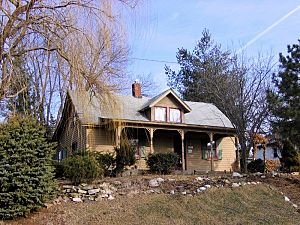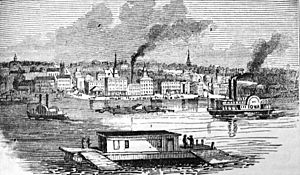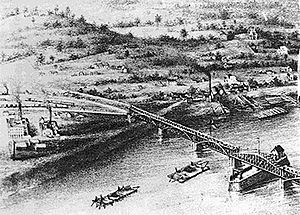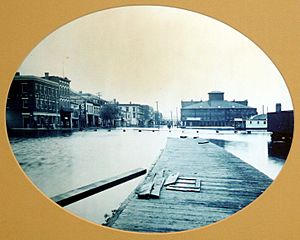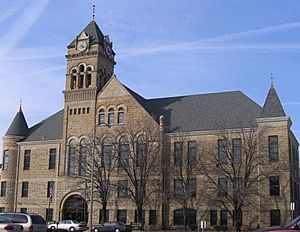History of Davenport, Iowa facts for kids
Davenport, Iowa, has a rich history, starting as part of the Louisiana Purchase. During the War of 1812 in 1814, British soldiers and Native American tribes like the Saux and Fox fought against American forces near Davenport. Major Zachary Taylor, who later became a U.S. President, even fought a battle east of what is now Credit Island Park. An important military outpost called Fort Armstrong was set up nearby, where key figures like George Davenport and Antoine LeClaire were stationed.
Antoine LeClaire officially founded Davenport in 1836, naming it after his good friend, Colonel George Davenport. Many of the first settlers in Davenport were from Germany. After a big argument over which town would be the "county seat" (the main town for government) with nearby Rockingham in 1840, Davenport won and became the county seat of Scott County. Just before the Civil War, Iowa's Governor Samuel J. Kirkwood declared Davenport as the state's first military headquarters. In November 1865, the Iowa Soldiers' Orphans' Home opened in Davenport to care for children who lost their parents in the Civil War. The city hall was built in 1895, and in 1897, the world's first chiropractic school, Palmer Chiropractic College, opened its doors.
Davenport saw a period of great growth and building in the 1920s and early 1930s. Many famous buildings from this time, like the Kahl Building and the Capitol Theatre, Modern Woodmen Park (the baseball stadium), the Parker Building, and the Blackhawk Hotel, are still standing today. However, the Great Depression brought tough economic times. New factories in the 1940s and 1950s helped the economy recover after World War II. The city faced hard times again in the 1980s during the farm crisis, when the Caterpillar Plant closed, causing many people to lose their jobs. But Davenport bounced back in the 1990s and continues to grow with new buildings and improvements.
Contents
Davenport's Early History (1800s)
Founding the City
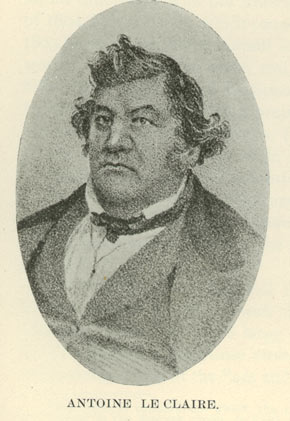
In 1832, a peace treaty was signed between Chief Keokuk and General Winfield Scott to end the Black Hawk War. Antoine LeClaire, who was part French and part Pottawattamie, helped by translating. Chief Keokuk gave a large piece of land to Antoine's wife, Marguerite LeClaire, because she was the granddaughter of a Sac chief. The only condition was that Antoine had to build their home exactly where the treaty was signed. He did, finishing the Treaty House in the spring of 1833. A few years later, in 1836, Antoine LeClaire officially founded the city of Davenport, naming it after his good friend, Colonel George Davenport.
Colonel Davenport arrived in the area in 1816 when Fort Armstrong was built. He worked as a "sutler," which meant he supplied goods to the army at the fort. Fort Armstrong was located on Arsenal Island. Its main job was to watch over the fur trade and keep peace among the local Native American tribes. Colonel Davenport also helped plan and map out the community that is now known as the Quad Cities. He even helped create plans for the first railroad bridge to cross the mighty Mississippi River.
The County Seat Challenge
In 1837, soon after Scott County was formed, Davenport and its nearby rival, Rockingham, both wanted to be the county seat. The Iowa Territory government said that the city with the most votes in the February 1838 election would win. On the night before the election, Davenport's supporters secretly brought in workers from Dubuque so they could vote for Davenport. Davenport won the election!
However, Rockingham's supporters were very upset and complained to the territorial Governor. The Governor refused to accept the election results. A second election was planned for the following August. To stop people from bringing in outside voters again, the Governor required voters to have lived in the city for sixty days. Both cities tried to cheat as the second election got closer. Davenport won again, but only by two votes.
The Territorial Legislature then set a third election for the summer of 1840. As the August election approached, people in Rockingham started to lose interest in the fight. Antoine LeClaire's generous donation of $3,000, along with the hard work of other Davenport residents, made it hard for Rockingham to compete. Davenport easily won the third election. To make sure the county seat question would never come up again, Davenport quickly built the first county courthouse.
Davenport in the Mid-1800s
In the 1850s, people from Germany made up the largest group of settlers in Davenport. By 1858, more than one-fifth of Davenport's nearly 11,000 residents were German. The growing city needed a railroad bridge to connect to Illinois. Before the bridge, private ferryboats carried people, wagons, and goods across the Mississippi River.
In 1856, the first railroad bridge across the Mississippi River was built, connecting Davenport and Rock Island, IL. It was built by the Rock Island Railroad. Steamboat owners saw railroads as a threat to their business. On May 6, 1856, just weeks after the bridge was finished, a steamboat called the Effie Afton crashed into the bridge. The steamboat's owner, John Hurd, sued The Rock Island Railroad Company. The railroad company chose Abraham Lincoln as their lawyer for the trial.
The case, "Hurd v. Rock Island Bridge Company," was argued by Lincoln in Chicago on September 8, 1857. The jury couldn't agree, so the case was dismissed. Later, the United States House of Representatives looked into whether the bridge was blocking river navigation. They decided the bridge was a hazard because of its design and the strong current. However, they believed the courts should decide the matter. The case went all the way to the United States Supreme Court, which decided the bridge could stay.
Just before the Civil War began, Governor Samuel J. Kirkwood declared Davenport to be Iowa's first military headquarters. Five army camps were set up in Davenport during the war. Camp McClellan was the largest, located on the eastern edge of the city. Thousands of Iowa troops trained there. Camp McClellan had twenty wooden barracks, a stockade, headquarters buildings, and hospitals. A Davenport neighborhood, McClellan Heights, is named after this camp.
Hundreds of Iowa children were left without homes because of the Civil War. On November 16, 1865, the Iowa Soldiers' Orphans' Home opened. The first 150 children arrived from Keokuk, Iowa. Starting in 1876, the home also took in children from broken homes, not just orphans, from all over Iowa. The home was like a small town, with houses, a school, a tailor shop, and a chapel. It had three separate fires over the years. On November 9, 1887, a big fire destroyed the main building. Luckily, because the home had several separate buildings, all 350 children living there at the time were safe. The home closed in 1975, after helping over 12,000 children.
In 1872, Phebe Sudlow became the principal of Davenport High School. She was the first female principal in the United States. On June 19, 1874, Phebe Sudlow was then voted to be the Superintendent of Davenport Schools. She was also the first woman in U.S. history to be a public school superintendent.
In 1895, even during a tough national economic time, Davenport built a beautiful new City Hall. It cost about $90,000, which was a huge amount of money back then. The city built it without needing to borrow any money. In 1897, Palmer College of Chiropractic was founded by Daniel David Palmer. It was the first chiropractic school in the world.
Davenport in the 1900s
Early 20th Century Growth
On July 25, 1901, a large fire broke out on Davenport's east side. The fire burned for a long time, destroying eight blocks of buildings and causing a million dollars in damage. Thankfully, no one died in the fire.
The 1920s brought a time of economic growth and building. The city's skyline began to take shape with new commercial buildings like the Kahl Building and the Capitol Theatre, the Parker Building, and the American Commercial and Savings Bank. Large national department stores like Montgomery Wards, Sears, and J.C. Penney also opened downtown. The Blackhawk Hotel was built downtown in 1915. It originally had seven stories, but four more floors were added in the 1920s, making it a 400-room hotel. The Blackhawk has hosted many famous people, including Carl Sandburg, Herbert Hoover, Richard Nixon, and Jack Dempsey.
On Christmas Day in 1920, 10,000 people came to see the grand opening of Davenport's new theater, the Capitol Theatre. The Capitol Theatre had a beautiful interior, an orchestra pit, and a full theater organ. Its third balcony reached five stories high! The theater's 2,000 seats were often full. On February 18, 1922, WOC Radio began broadcasting. WOC was the second radio station ever licensed in the country. In 1933, WOC hired future President Ronald Reagan as a staff announcer.
In 1930, efforts began to turn a city dump into a landmark. The plan was to build a municipal stadium, now called Modern Woodmen Park. This project cost over $150,000 and was paid for with bonds. It had special features like reserved seats, box seats, and night lighting. The stadium hosted Saint Ambrose University football games and boxing matches. Today, it's the home of the Quad Cities River Bandits baseball team.
By 1932, thousands of people in Davenport were receiving public assistance because of the Great Depression. A shantytown, or "Hooverville," grew in the west end of the city along the Mississippi River. This area suffered from sickness, hunger, and poor living conditions. The federal Civil Works Administration provided jobs for thousands of men, who worked to extend the seawall along the riverfront. More than 200 jobs were created by the construction of the Lock and Dam 15 project in 1932. Hundreds of state employees also worked on completing the Kimberly Road Outerbelt Bypass in 1936.
Mid-Late 20th Century Changes
In 1946, Alcoa decided to build a new factory east of Davenport in Riverdale, Iowa. This construction helped end concerns about unemployment after World War II. The way people shopped in Davenport changed when cars became more common. In the late 1940s, parking meters were put downtown to help more people find parking spots. Soon, there were more cars than street parking could handle. In 1953, Iowa's first multi-story parking garage was built at Fifth Street and Brady Street. Even with new shopping centers opening, downtown remained a popular retail area.
The deadliest fire in Davenport's history happened on January 7, 1950. Forty-one people died in a fire at St. Elizabeth's Hospital, a mental ward run by Mercy Hospital.
Davenport experienced a boom in its economy and population after World War II. Companies like Oscar Mayer and Ralston Purina built plants in west Davenport. In 1956, the Interstate highway network came to Davenport. Local transportation planning changed after World War II. Paved state and federal highways built in the 1930s were expanded to handle new truck shipping. In 1960, a second part of the Iowa-Illinois Memorial Bridge was built to help with increased traffic. The first section of Interstate 80 also opened that year. Other Interstate highways, 74 to the east and 280 to the west, opened in the 1960s and early 1970s.
By 1959, more than 1,000 homes were being built each year. However, by the late 1970s, the economic growth slowed down for both downtown and local businesses. The farm crisis of the 1980s hit Davenport and the rest of the Quad Cities very hard, leading to high unemployment and financial difficulties. About 35,000 workers lost their jobs across the entire Quad Cities area. The Caterpillar Plant on the city's north side closed, causing many job losses.
In the late 1970s, Davenport city leaders began planning to build a civic center downtown. This center was meant to help bring new life to downtown's struggling property values. In December 1983, after sixteen months of construction, the civic center opened. After a public contest, it was named the RiverCenter. The nearby Orpheum Theatre was renamed the "Adler Theater" and managed by the RiverCenter. In the late 1970s, a large shopping mall was built, drawing most customers away from downtown and causing its own economic downturn.
The 1990s brought the start of an economic comeback for the city. Many buildings were renovated and new additions were made to revitalize downtown. These projects included fixing up Modern Woodmen Park, building the Skybridge, and the Figge Art Museum, along with many other improvements.
Davenport (along with its neighbor Rock Island, Illinois) won the "2007 City Livability Award" in the small-city category from the U.S. Conference of Mayors. This award recognized the achievements of the "RiverVision" plan for Davenport and Rock Island, which aimed to make urban areas safer, cleaner, and more livable.
List of Mayors of Davenport
|
|
|


